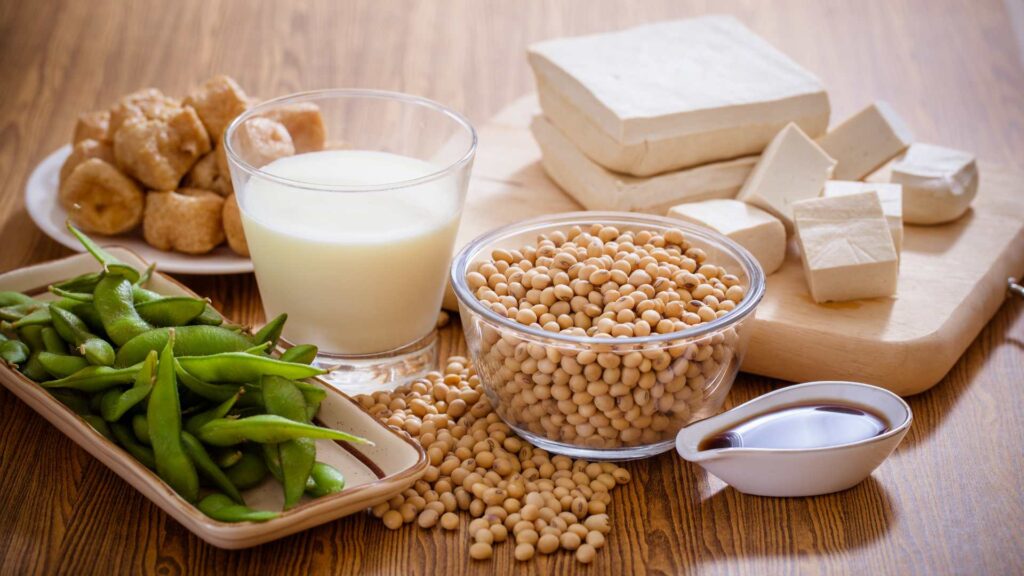The soybean has deep roots in East Asian food culture going back thousands of years, but its role as an industrial food crop really took off in the 20th century, a hundred years or so after it was introduced to Europe and North America. What once was a viable healthy food changed when industrialization genetically modified it in labs.
What Are Soy Products?
Soy shows up in many common foods, sometimes in ways you might not expect. Because it is so widespread, it often becomes a hidden staple in many diets, or people seek it out because they believe it is a good plant-based source of protein (soy is actually a greater source of fat). Popular products include:
- Tofu
- Edamame
- Miso
- Soy nuts
- Soy pasta
- Soy protein isolate
- Soy sauce
- Textured Vegetable Protein (TVP)
- Soy protein powder
- Artificial meat substitutes
- Soy milk
GMOs: Ruining Viable Foods
The main issue with soy is that most of the crop grown today is a genetically modified organism (GMO), also termed bioengineered. They were introduced in 1996 by Monsanto under the brand Roundup Ready Soybeans, engineered to tolerate glyphosate herbicide. Today, the soybean is the largest genetically modified crop grown in the world, with over 90% of U.S. soybeans grown being genetically modified.
Here’s why GMOs raise health concerns:
- GMO foods feed pathogens and no longer fight them
- Soy products often contain MSG
- They act as brain disruptors. Instead of supporting the brain, they leave it vulnerable.
- GMO nutrients are man-made and foreign to the body, so we can’t convert them into usable nutrition
- They are toxic to our bodies and lower our immune system
- Triggers a histamine reaction in the body and heightens inflammation
- There is no definitive way to be sure you are eating non-GMO foods because cross contamination is so commonplace
- The liver cannot convert GMO nutrients to make them useable because they are foreign
Why Soy Isn’t Great for Health
Even beyond the GMO issue, soy itself comes with challenges:
- High fat content – The soybean is rich in fats, and this makes it hard for your body to cleanse
- Glucose inhibitor – The fat in soy thickens the blood and slows down glucose absorption
- Burden on the liver – A high-fat diet makes it harder for the liver to cleanse and regenerate
A Brain Betrayer
Soy is a brain betraying food- the information in food that our brains gather when we eat them and disseminate to our body changes when they are genetically modified. The lines of communication are cut, and the information becomes destructive to our bodies. The reason that we eat food for our brain specifically is in part to protect it from oxidative stress and free radicals, and this goes out the window when we eat GMOs. Genetically modified foods make our brains vulnerable to these stressors.
…GMO (bioengineered) food break those communication lines. Our brain does not adapt to GMO foods. Our brain is not man-made. The first human being wasn’t created as a science project in a GMO lab, and neither were our foods up until this time in history. All GMO foods are brain disruptors. They are the ultimate brain betrayers because the messaging inside that GMO food is destructive. -Medical Medium Brain Saver, by Anthony William, pg. 140
Who Should Avoid Soy Products?
Soy can be especially disruptive if you’re dealing with:
- Brain or nervous system issues- soy interferes with neurotransmitter hormones, important amino acids, enzymes, and important chemical compounds that the brain needs to stay healthy.
- Insulin resistance
- Any sort of condition- bottom line is for those focused on healing, soy is more of a burden than a help
Viruses and bacteria especially proliferate when we’re eating eggs, milk, cheese, butter, all other dairy products, gluten, soy, pork, corn, or an overall high-fat diet. -Medical Medium Brain Saver by Anthony William, pg. 133
Alternatives to Soy Products
The good news is that there is a pumpkin seed tofu (called “Pumfu”), a versatile soy-free alternative, if you really like tofu. You can also rely on other plant proteins like beans, lentils, chickpeas, and seeds (for more healthy soy replacements check out my food guide below). For a fermented soy-like alternative try out coconut aminos, it has a savory-sweet flavor that a lot of people like and that you can find used in Medical Medium recipes, like this stir-fry sesame noodle recipe.
If you do choose soy stick with the cleanest options and use as sparingly as possible. Remember that just because something is labeled organic doesn’t guarantee it’s non-GMO. Always look deeper when choosing your food whether in the store, at home, or at a restaurant. Opt for plain, organic tofu or tempeh preferably made from sprouted soybeans, and a high-quality gluten-free nama shoyu.
To your health and happiness,
Muneeza
P.S Are you looking for more inspiration on your journey from the Standard American Diet? I have created The Ultimate Clean Food Guide, a FREE DOWNLOAD, with all of the Medical Medium® friendly foods I recommend. I cover everything from burgers, bread, pancakes, to dessert, canned food, pre-made meals, and more.






